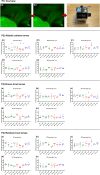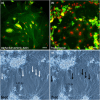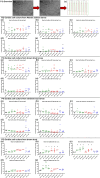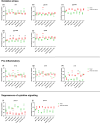Use of cardiac cell cultures from salmonids to measure the cardiotoxic effect of environmental pollutants
- PMID: 39343838
- PMCID: PMC11646967
- DOI: 10.1111/jfd.14018
Use of cardiac cell cultures from salmonids to measure the cardiotoxic effect of environmental pollutants
Abstract
Environmental stressors such as micro- and nanosized plastic particles (MNPs) or crude oil have a detrimental effect on aquatic animals; however, the impact upon the cardiovascular system of fish remains relatively under-researched. This study presents a novel approach for investigating the effect of crude oil and MNPs on the cardiac system of fish. We used salmonid larvae and cardiac cell cultures derived from hearts of salmonid fish and exposed them to environmental stressors. Following exposure to plastic particles or crude oil, the larvae exhibited some variation in contraction rate. In contrast, significant alterations in the contraction rate were observed in all cardiac cell cultures. The greatest differences between the control and treatment groups were observed in cardiac cell cultures derived from older brown trout. Following 7 days of exposure to MNPs or crude oil in Atlantic salmon larval hearts or cardiac cell cultures, there were only minor responses noted in mRNA expression of the selected marker genes. These findings show the use of a novel in vitro technique contributing to the existing body of knowledge on the impact of MNPs and crude oil on the cardiovascular system of salmonids and the associated risk.
Keywords: cell cultures; crude oil; heart; microplastic; nanoplastic.
© 2024 The Author(s). Journal of Fish Diseases published by John Wiley & Sons Ltd.
Conflict of interest statement
The authors declare that research was conducted in the absence of any commercial or financial relationships that could be construed as a potential conflict of interest.
Figures




Similar articles
-
Low-level embryonic crude oil exposure disrupts ventricular ballooning and subsequent trabeculation in Pacific herring.Aquat Toxicol. 2021 Jun;235:105810. doi: 10.1016/j.aquatox.2021.105810. Epub 2021 Mar 22. Aquat Toxicol. 2021. PMID: 33823483
-
Toxic effects of crude oil combined with oil cleaner simple green on yolk-sac larvae and adult rainbow trout Oncorhynchus mykiss.Environ Sci Pollut Res Int. 2005;12(3):136-9. doi: 10.1065/espr2005.04.245. Environ Sci Pollut Res Int. 2005. PMID: 15986996
-
Cardiovascular responses of three salmonid species affected with amoebic gill disease (AGD).J Comp Physiol B. 2005 Oct;175(7):523-32. doi: 10.1007/s00360-005-0020-4. Epub 2005 Oct 26. J Comp Physiol B. 2005. PMID: 16088392
-
The Minderoo-Monaco Commission on Plastics and Human Health.Ann Glob Health. 2023 Mar 21;89(1):23. doi: 10.5334/aogh.4056. eCollection 2023. Ann Glob Health. 2023. PMID: 36969097 Free PMC article. Review.
-
Physiological Responses of Fish to Oil Spills.Ann Rev Mar Sci. 2021 Jan;13:137-160. doi: 10.1146/annurev-marine-040120-094802. Epub 2020 Aug 4. Ann Rev Mar Sci. 2021. PMID: 32749906 Review.
Cited by
-
Beating Cardiac Cell Cultures From Different Developmental Stages of Rainbow Trout as a Novel Approach for Replication of Cardiac Fish Viruses.J Fish Dis. 2025 May;48(5):e14080. doi: 10.1111/jfd.14080. Epub 2025 Jan 17. J Fish Dis. 2025. PMID: 39821901 Free PMC article.
References
-
- Ali, A. O. , Hohn, C. , Allen, P. J. , Ford, L. , Dail, M. B. , Pruett, S. , & Petrie‐Hanson, L. (2014). The effects of oil exposure on peripheral blood leukocytes and splenic melano‐macrophage centers of Gulf of Mexico fishes. Marine Pollution Bulletin, 79(1–2), 87–93. 10.1016/j.marpolbul.2013.12.036 - DOI - PubMed
MeSH terms
Substances
Grants and funding
LinkOut - more resources
Full Text Sources

